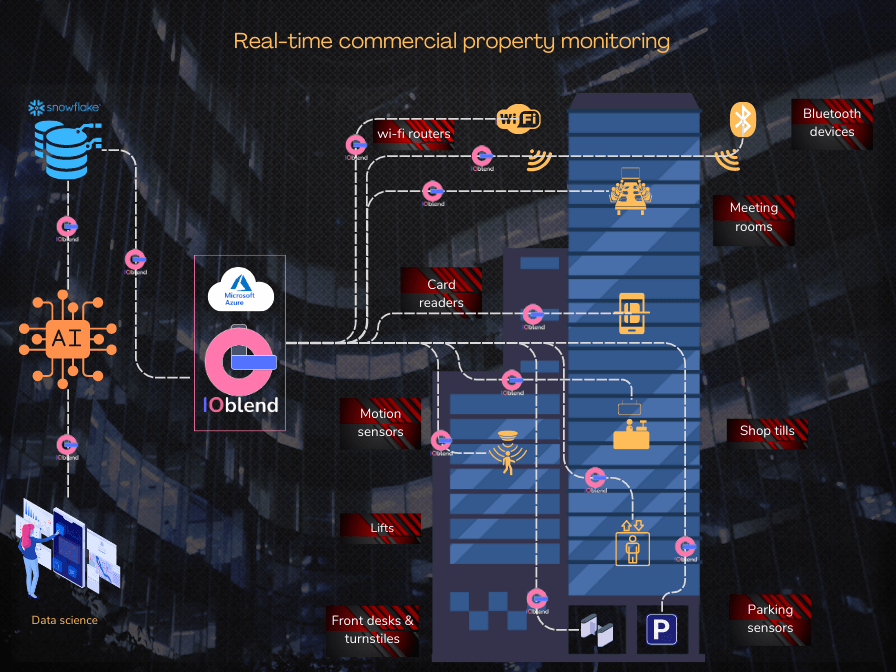Commercial property
Welcome to the next issue of our real-time analytics blog. This time we are taking a detour from the aviation analytics to the world of commercial property management. The topic arose from a use case we are working on now at IOblend. It just shows how broad a scope is for real-time data applications pretty much everywhere we look.
Commercial property covers everything, from offices, to shops, to warehouses, etc. Government buildings, airports, hotels, amusement parks – they all fall into this category of property or real estate. These properties have one essential feature in common: they act as focal points for people to perform work, particularly office buildings.
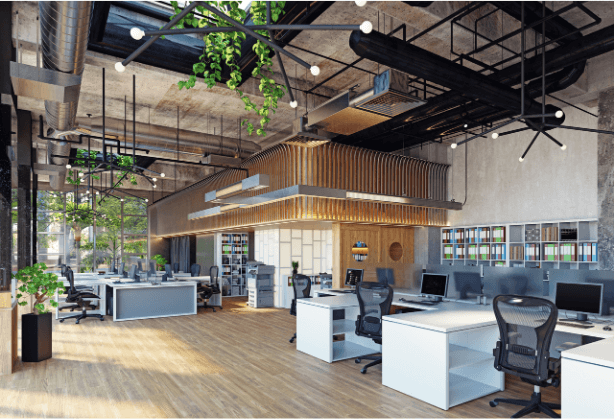
Post-pandemic changes
Offices generally see a lot of use, so they require constant management to keep the buildings and facilities fit for purpose, cater for the workers’ needs and comply with health and safety regulations. Ground rents and upkeep are expensive, so property managers also need to maximise occupancy rates to be financially viable.
COVID 19 has changed the way we work (perhaps forever), so we no longer use the office space as much as we used to. Companies downsize their offices, meaning they require less space, thus reducing the rents they pay. Property managers then face under-utilised buildings, diminishing rent income and high maintenance costs (you still need to do upkeep). They needed to get smarter and more creative to lure people back into the buildings, which is now leading towards new interior designs, healthier food options, more co-working spaces, etc.
But how would you know what measures make a material difference?
As you may have correctly guessed it, data is used extensively by large property management companies to inform their operations. They use multiple data feeds such as lease agreements, utility bills, maintenance records, catering/shops sales, parking stats, front desk registry and turnstiles, meeting room bookings, surveys, etc. They collate and analyse this data manually to derive general trends and financial forecasts. The analysis is always static and only shows a limited picture.
But how would you know what measures make a material difference?
- Once inside, what do the tenants do besides occupying their desks?
- What areas do they visit and at what times?
- Do they go anywhere aside from using the restrooms and kitchens in their respective areas?
- How do they split their time between the desks, break-out areas, social spaces, and meeting rooms?
- Are there any consistently under-utilised spaces that could be converted to different purposes?
- If we invest in more attractive facilities, will they bring more customers?
It is challenging from a technical perspective to track what is happening inside the building at any given time, especially considering the privacy aspect – we, humans, do not like being constantly scrutinised by an unseen eye.
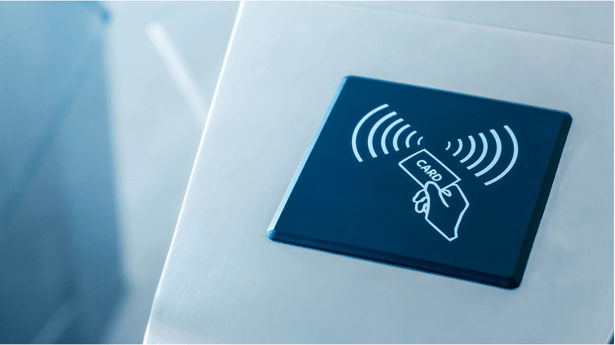
So here lies the challenge:
Property management companies want an ability to monitor activity inside the buildings in real-time but at the same time they must preserve privacy and remain unintrusive to the workers. Oh, and the system must not cost a fortune to build and maintain.
We have recently started to collaborate to bring one such capability to reality. While some solutions on the market today provide information about the building usage, they tend to analyse data from static data sources. IOblend connects to any source that produces data and processes it in-memory, performing multiple complex transformations in real-time cost-effectively. We process data in real-time in the customer’s cloud infra (MS Azure here).
In this case the project involves live entries from the front desks, turnstile scans, lift panels, meeting room reservations systems, wi-fi routers, motion sensors, Bluetooth devices, shop tills, parking sensors and internal card readers. Any personal data gets anonymised before we stream it to the warehouse (they use Snowflake).
A custom analytics suite then maps this data onto a virtual layout of the building and produces a visual representation of the interior activity, allowing property managers to analyse how the building is being used at any given time.
It’s early days still, but the insights from just one office already identified poorly utilised spaces and overcrowded areas (and the underlying causes), showed people flows by time of day across the entire building, and highlighted a potential to easily save energy. Interestingly, the project is not dissimilar to the one we described earlier for airport passenger tracking.

The next phase is to integrate an AI model to start introducing predictive maintenance capabilities. In parallel, they are also experimenting with the LLM to dynamically run comparisons with other properties in their portfolio and general market. Very exciting times for real-time data indeed.
If you are considering real-time analytics capabilities for your commercial property portfolios, get in touch today and let us show you the art of the possible.
Resolving the complexities of managing offices with real-time data, as opposed to common methods, involves a transformative approach that IOblend offers. Traditional property management relies on static data sources like lease agreements and utility bills, which only provide a limited view. IOblend, on the other hand, utilizes real-time data from diverse sources like front desk entries, turnstile scans, and sensor data, processed cost-effectively in the cloud. This approach allows property managers to gain instantaneous insights into space utilization, people flow, and energy consumption, enabling more informed decision-making. By mapping this data onto a virtual layout of buildings, IOblend not only enhances operational efficiency but also respects privacy concerns, a vital aspect in today’s data-driven world.

Mind the Gap: Bridging Data Silos with IOblend Integration
Mind the Gap: Bridging Data Silos to Unlock Organisational Insight 💾 Did you know? Back in the early days of computing, data integration often involved physically moving punch cards between different machines – a rather less streamlined approach than what we have today! Piecing Together the Data Puzzle At its core, data integration is about

Rapid AI Implementation: Moving Beyond Proof of Concept
Rapid AI Implementation: Moving Beyond Proof of Concept 💻 Did you know that in 2024, the average time it took for a business to deploy an AI model from the experimental stage to full production was approximately six months? Bringing AI Experiments to Life The journey of an AI project typically begins with a “proof
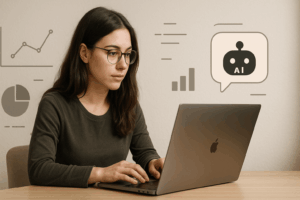
Agentic AI ETL: The Future of Data Integration
Agentic AI ETL: The Future of Data Integration 📓 Did you know? By 2025, the volume of data generated globally is projected to reach 175 zettabytes? That’s a truly enormous number, highlighting the ever-increasing importance of efficient data management. What is Agentic AI ETL? Agentic AI ETL represents a transformative evolution in data integration. Traditional

Break Down the Data Walls with IOblend
Break Down the Data Walls with IOblend 📑 Did you know? It’s estimated that a whopping 80% of business data is just floating about, unstructured and stuck in siloed systems. Siloed data only brings value (if at all!) to the domain it belongs to. But the true value lies in the insights in brings to
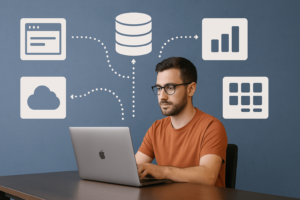
Put a Stop to Data Chaos with IOblend Governed Integration
Put a Stop to Data Chaos with IOblend Governed Integration 🤯💥Did you know? By 2025, the global datasphere is projected to grow to 175 zettabytes? This staggering figure underscores the sheer scale of data businesses must manage, making simplification not just a luxury, but a necessity. Today, businesses don’t have a shortage of data. What

Optimising Customer Experience Through Real Time Data Sync
Optimising Customer Experiences Through Real Time Data Sync 🧠 Fun Fact: Did you know that 90% of the world’s data has been created in just the past two years? That’s a lot of information to manage – and a massive opportunity for businesses that know how to use it wisely. Understanding your customers is the

